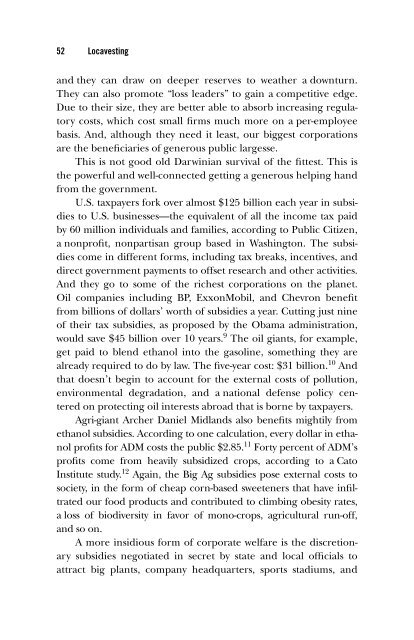3c hapter - Index of
3c hapter - Index of
3c hapter - Index of
You also want an ePaper? Increase the reach of your titles
YUMPU automatically turns print PDFs into web optimized ePapers that Google loves.
52 Locavesting<br />
and they can draw on deeper reserves to weather a downturn.<br />
They can also promote “loss leaders” to gain a competitive edge.<br />
Due to their size, they are better able to absorb increasing regulatory<br />
costs, which cost small fi rms much more on a per- employee<br />
basis. And, although they need it least, our biggest corporations<br />
are the benefi ciaries <strong>of</strong> generous public largesse.<br />
This is not good old Darwinian survival <strong>of</strong> the fi ttest. This is<br />
the powerful and well- connected getting a generous helping hand<br />
from the government.<br />
U.S. taxpayers fork over almost $125 billion each year in subsidies<br />
to U.S. businesses—the equivalent <strong>of</strong> all the income tax paid<br />
by 60 million individuals and families, according to Public Citizen,<br />
a nonpr<strong>of</strong>i t, nonpartisan group based in Washington. The subsidies<br />
come in different forms, including tax breaks, incentives, and<br />
direct government payments to <strong>of</strong>fset research and other activities.<br />
And they go to some <strong>of</strong> the richest corporations on the planet.<br />
Oil companies including BP, ExxonMobil, and Chevron benefi t<br />
from billions <strong>of</strong> dollars’ worth <strong>of</strong> subsidies a year. Cutting just nine<br />
<strong>of</strong> their tax subsidies, as proposed by the Obama administration,<br />
would save $45 billion over 10 years. 9 The oil giants, for example,<br />
get paid to blend ethanol into the gasoline, something they are<br />
already required to do by law. The fi ve- year cost: $31 billion. 10 And<br />
that doesn’t begin to account for the external costs <strong>of</strong> pollution,<br />
environmental degradation, and a national defense policy centered<br />
on protecting oil interests abroad that is borne by taxpayers.<br />
Agri- giant Archer Daniel Midlands also benefi ts mightily from<br />
ethanol subsidies. According to one calculation, every dollar in ethanol<br />
pr<strong>of</strong>i ts for ADM costs the public $2.85. 11 Forty percent <strong>of</strong> ADM’s<br />
pr<strong>of</strong>i ts come from heavily subsidized crops, according to a Cato<br />
Institute study. 12 Again, the Big Ag subsidies pose external costs to<br />
society, in the form <strong>of</strong> cheap corn- based sweeteners that have infi ltrated<br />
our food products and contributed to climbing obesity rates,<br />
a loss <strong>of</strong> biodiversity in favor <strong>of</strong> mono- crops, agricultural run- <strong>of</strong>f,<br />
and so on.<br />
A more insidious form <strong>of</strong> corporate welfare is the discretionary<br />
subsidies negotiated in secret by state and local <strong>of</strong>fi cials to<br />
attract big plants, company headquarters, sports stadiums, and
















